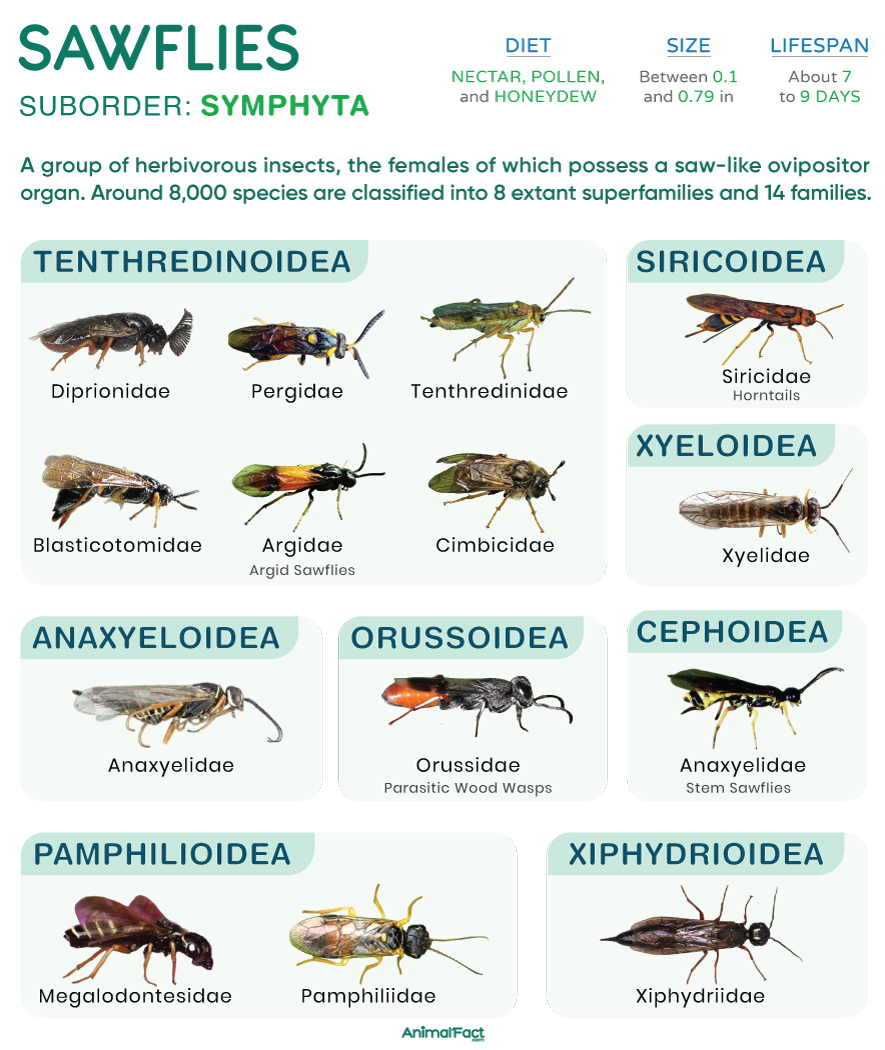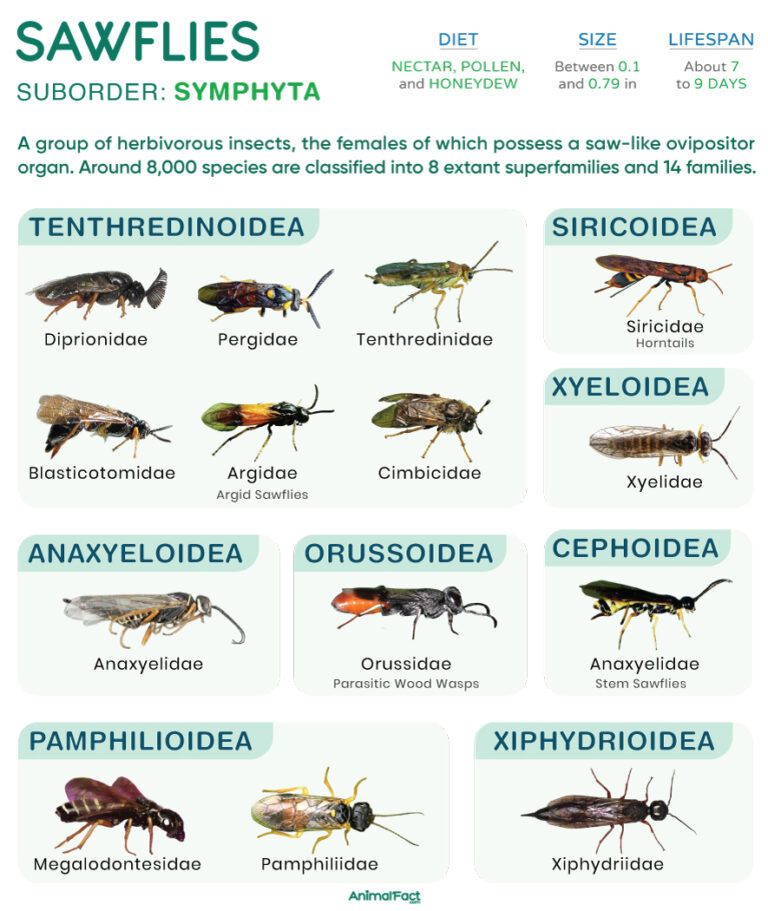


Sawflies are a group of insects that constitute the suborder Symphyta. Together with bees, ants, and wasps (which make the suborder Apocrita), they constitute the order Hymenoptera. Unlike members of Apocrita, sawflies do not have a narrow waist (petiole); instead, their thorax and abdomen are broadly joined. These insects derive their name from the saw-like ovipositor organ found at the tip of the abdomen in females.

Around 8,000 species of sawflies are found worldwide (except in the polar regions), with their diversity highest in the temperate regions.
They typically range between 0.1 and 0.79 in (2.5 to 20 mm). However, the larvae of one of the largest species, the elm sawfly (Cimbex americanus), measure up to 1.9 in (50 mm).[1] Among extinct species, Hoplitolyda duolunica from the Mesozoic Era measured as much as 2.1 in (55 mm).
Like all insects, sawflies have a tripartite body plan, comprising three distinct segments: head, thorax, and abdomen.
The anteriormost part of the body, the head, comprises a pair of compound eyes (as well as three simple eyes or ocelli in some species), chewing-type mandibles, and a pair of thread-like, segmented antennae. The total number of antennal segments may reach up to 30 or more in members of the family Pamphiliidae.
The head is also hypognathous, meaning the mouthparts are directed downwards.
The thoracic region is subdivided into three segments, the pro-, meso, and metathorax, each bearing a pair of legs. The mesothorax and the metathorax each bear a pair of membranous wings, with the forewings being larger than the hindwings.
Unlike ants, bees, and wasps, the thorax of sawflies is joined broadly with the abdomen, without a narrow, waist-like petiole.
The abdominal region bears up to 10 visible segments. It houses most of the digestive system and the reproductive organs.
Female sawflies possess a prominent, saw-like ovipositor at the tip of the abdomen, which they use to cut slits into leaves, stems, or plant tissue to lay eggs inside. Unlike bees and wasps, the ovipositor is not modified into a sting.
Most males bear a pair of claspers that help them hold their mate during copulation.
As of 2013, around 8,000 species are classified into 8 extant superfamilies and 14 families.
The oldest unambiguous fossils of these insects date back to the Triassic Period (around 250 million years ago). In fact, fossils of the family Xyelidae are the oldest among all hymenopterans.
Sawflies are found on all continents except Antarctica. Their largest family, Tenthredinidae, is the most abundant and diverse in the temperate regions of the Northern Hemisphere. Other families, such as Blasticotomidae and Megalodontidae, are Palearctic, whereas Xyelidae, Pamphilidae, Diprionidae, Cimbicidae, and Cephidae have a Holarctic distribution.
They typically thrive in deciduous and mixed forests, though some species also occupy shrublands and grasslands. Some species of the genus Dolerus are found in coastal marshes.[2]
Several species, such as the rose sawfly (Arge ochropus) and Caliroa cerasi, are found in man-made habitats, including gardens, orchards, hedges, and plantations.
Adult sawflies typically feed on nectar, pollen, or honeydew. The larvae, on the other hand, are primarily folivores, consuming the leaves of trees, shrubs, or other plants, including pines, willows, birches, and roses. Some sawflies, such as members of the genus Euura, form galls on willow trees, live in them, and feed on the nutritive tissues within the galls.[3]
Adult sawflies are short-lived, surviving usually about 7 to 9 days, a span long enough for them to mate and lay their eggs. In contrast, the larvae may live for months to years, depending on the species.[4]
Although most sawflies reproduce sexually, some species, such as the willow sawfly (Nematus oligospilus), undergo asexual reproduction through parthenogenesis, in which the females do not require fertilization to produce viable eggs.[5] In such parthenogenetic species, the unfertilized eggs develop into males, while fertilized ones form females.
In sexually reproducing species, the females typically release sex pheromones to attract males, who detect these chemical cues with their antennae. Once the pair forms, the male grasps the female with his claspers, mounts her, and transfers sperm to her reproductive tract.
After fertilization, the female lays 30 to 90 eggs within leaf tissues in well-lit areas. Since sawflies are holometabolous insects, the eggs typically hatch into larvae in 2 to 8 weeks.
In 2 to 4 months, the larvae feed, undergo 6 molts, and burrow themselves en masse into the soil to transform into pupae. Some species, such as the elm zigzag sawfly (Aproceros leucopoda), spin silken cocoons attached to leaves or twigs.
When the pupa matures, the pupal chamber breaks open, and the adult emerges with fully functional wings.
Both adult and larval sawflies fall prey to a range of bird predators, including currawong (Strepera), stonechats (Saxicola), chestnut-backed chickadees (Poecile rufescens), black grouse (Tetrao tetrix), and partridges. In fact, their chicks, in particular, show a strong preference for sawfly larvae.[6][7] Some other birds, such as pardalotes, honeyeaters, and fantails, have been found to consume sawfly eggs.
Other predators include carnivorous mammals such as the masked shrew (Sorex cinereus), the northern short-tailed shrew (Blarina brevicauda), and the deer mouse (Peromyscus maniculatus), which consume sawfly cocoons. Additionally, some predatory beetles, assassin bugs, ants, and predatory wasps (especially the families Braconidae, Eulophidae, and Ichneumonidae) feed on larvae and pupae.
Frogs and lizards may opportunistically feed on these insects.